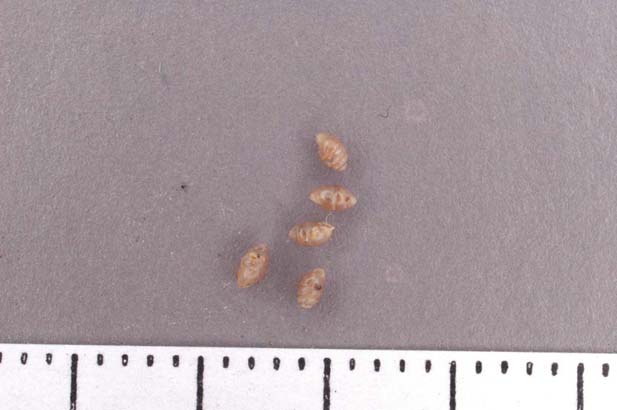
Adaptation
 Vertigo
tridentata has many adaptations that give them the best
chance for survival in their environment. The genus Vertigo
in general have been described as having a finely-hones penis
and a smooth uterus. Each individual snail, including the
species Honey Vertigo, has each of these reproductive organs
meaning they are hermaphroditic (Pilsbry,
1948). A hermaphrodite is an organism that has functional
male and female reproductive organs and can produce sperm and
eggs (Hickman, 2009).
Vertigo
tridentata has many adaptations that give them the best
chance for survival in their environment. The genus Vertigo
in general have been described as having a finely-hones penis
and a smooth uterus. Each individual snail, including the
species Honey Vertigo, has each of these reproductive organs
meaning they are hermaphroditic (Pilsbry,
1948). A hermaphrodite is an organism that has functional
male and female reproductive organs and can produce sperm and
eggs (Hickman, 2009).
Vertigo tridentata, being from the Phylum Mollusca, have a thick, muscular foot which is used for their movement (Hickman, 2009). The movement of their foot is observed as a constant two or three waves rhythmically pulsating from the front of the foot to the rear (Pilsbry, 1948). Their thick, spiral shell, which is common throughout the Class Gastropoda, provides many functions for the snails. It is a great defense and protection against any predator. The shell is calcareous, meaning it is composed of calcium carbonate (CaCO3), which gives it strenght and rigidity (Encyclopedia of Life, 2011). The Honey Vertigo snail's shell is a honey-yellow to a brown color. This coloration helps the snail survive and strive in their environment because they are camouflaged and blend with the forest floor, the dirt, and rotting wood (Pilsbry, 1948). Their shell is not only used for protection against predators, but also for protection during the harsh winter weather. The snail retracts back into it's shell to hibernate during the winter months (Encyclopedia of Life, 2011).
Possibly the biggest and most advantageous adaptation for the Vertigo tridentata comes from the characteristics of the Order Stylommatophora. These snails have a great degree of cephalization and have two pairs of retractable tentacles (Encyclopedia of Life, 2011). Cephalization is simply the grouping or localization of sensory organs and nervous system in the head or anterior region of the organism (Hickman, 2009). The two pairs of tentacles found on the Honey Vertigo, a smaller and a larger pair, are use for sensing their surroundings. The longer, larger pair contain eyes on the end of the tentacle (Encyclopedia of Life, 2011).
Discover how the Honey Vertigo receives its
Nutrition.
Or, return to the Home page.